How did you get here?
V and I are staying with Santa Babara friends in a Grasse, Fr home exchange. They will be here for a month, we won’t be here long enough based on today’s experiences. The destination is Cabris, just 4 km away from the house. It’s late afternoon just enough time for a short walk, an aperitiff, and a simple meal. We drove, in first gear, straight up this tiny mountain road. If there is another car coming down we will not make it. Rick Steve’s described it as a ”second gear road”, I barely got it out of first. When the French built this path they thought why do we need switchbacks when we can go straight up? As we crested the hill there is a tour bus on another road used by all the people that actually know how to get here. We had earlier changed the GPS setting to country roads, maybe that was the problem.
The four of us walked past the church and to the edge of the village for an expansive view of the Grasse countryside and the sea beyond. A woman that heard us talking approached us and asked if we were Americans and how did we get here? Yes, and do you know that road? Tracy is a lithe woman in her mid years, an American divorcee from San Diego. Coincidentally, the same place as our Grasse hosts. She teaches English to the unemployed French so they have more opportunities in the hospitality industry. We meet Pierre her handsome french bf, who is quite fluent in English. I think he may be taking some night classes from Tracy. They give us the a ten minute primer on the local must sees. Pierre explains he grew up in Cannes, rides motorcycles and knows the roads well.
We head to off to the main square to continue our investigation of this little town. After some time Tracy shows up at the square and introduces us to Susan, a hiker in her late forties a divorcee from Hawaii, whose lives part time in Cabris. Susan asks us how we got here. I answered you know the road? Susan says, No I mean how do you know about this place? She is thinking she has one of the few keys to the village. At this point there is pattern of coincidences developing here. After V and I share stories of Oahu she invites us all back to the home she bought two years ago. It’s a modest three bedroom with a Cezannesque Cote De Azur painting out of every window. In the basement where the the horses and goats once lived are two massive motorcycles, a Ducati and Motobecane. We all assume that they belong to Pierre, picturing Tracy hanging on to bf as he speeds though France and Italy. Nope these are hers, I’m guessing that the Ducati is 800cc. If you divide that by about eight you get Tracy’s weight. She must need a seat belt and duct tape to stay on the bike at speed.
There are some very interesting people in this town.
If you think you can keep up, the Ducati dealership in Marseille opens and 9:00 am on most days.
Fact check: Cabris’ pop. is 1456. A mayor of the town from 2008-2014 was Pierre Bornet, maybe Tracy’s boyfriend?
Cabris, April 20th 2018
The smell of Grasse
 Heading out of Grasse this morning we start our journey back to the US. We both have mixed feelings about the return, but it’s time to go home. The trip was long, but felt just the right length. On the day we tired of the cold wet weather (in Pezenas), like magic, it changed and spring was in the air. Jackets shed we headed out with a new attitude. Spring in Provence is pretty special and we feel were we’re here on it’s very first day. There is no lavender yet but that’s a bloom worth coming back for. Grasse is the scent capitol of the world with a good portion of the potions coming from the area. It’s probably my imagination but every where you go it smells like flowers. The plants know that spring is coming and have started blooming even before the rain stopped, Grasse in full bloom.
Heading out of Grasse this morning we start our journey back to the US. We both have mixed feelings about the return, but it’s time to go home. The trip was long, but felt just the right length. On the day we tired of the cold wet weather (in Pezenas), like magic, it changed and spring was in the air. Jackets shed we headed out with a new attitude. Spring in Provence is pretty special and we feel were we’re here on it’s very first day. There is no lavender yet but that’s a bloom worth coming back for. Grasse is the scent capitol of the world with a good portion of the potions coming from the area. It’s probably my imagination but every where you go it smells like flowers. The plants know that spring is coming and have started blooming even before the rain stopped, Grasse in full bloom.
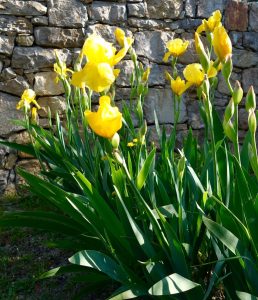 I had a negative view of the area before coming to France. I thought it would be a French Rivera experience full of noticeable wealth and bling. It is rather a series of towns with beautiful villas, pools, and landscaping sewn on the sides of steep hillsides like a patchwork quilt. The entrances are small openings covered in overgrown plantings that suggest the elegance beyond the driveway. The homes are taking advantage of the views that stretch to the Mediteranian. There is a more laid back attitude with friendly people in Provence than in the rest of the country. Definitely not as I had envisioned.
I had a negative view of the area before coming to France. I thought it would be a French Rivera experience full of noticeable wealth and bling. It is rather a series of towns with beautiful villas, pools, and landscaping sewn on the sides of steep hillsides like a patchwork quilt. The entrances are small openings covered in overgrown plantings that suggest the elegance beyond the driveway. The homes are taking advantage of the views that stretch to the Mediteranian. There is a more laid back attitude with friendly people in Provence than in the rest of the country. Definitely not as I had envisioned.
There is always a sigh of relief when we get the rental car back in one piece. I guess that is not always the case. The first thing the rental agent said when we pulled in is ”did you wreck our vehicle?” I asked how many out of ten come in damaged and he put the number at one or two. There are three agents that go over the vehicle like border crossing police, looking for shoddy body work, or other poorly disquised damage. When they said I was free to go I thought they may be taking their Hertz uniforms a bit seriously. The driving in France was just a little easier than Italy and Spain, but still challenging with very tiny roads, motorcycles passing in both directions (at the same time), and GPS directions that can be off the major roads on a regular basis. Make sure the insurance is in place. Close to the airport we filled gas in a very busy station where our €21 purchase turned into a $123.00 credit card charge, probably not an exchange rate issue. Be careful, sometimes the pocket that is picked is not actually from your pocket.
How did you get here?
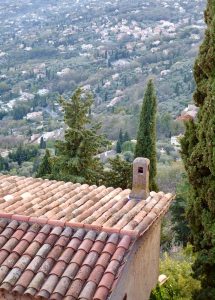 V and I are staying with Santa Barbara friends in a Grasse, Fr home exchange. They will be here for a month, we won’t be here long enough based on today’s experiences. The destination is Cabris, just 4 km away from the house. It’s late afternoon just enough time for a short walk, an aperitiff, and a simple meal. We drove, in first gear, straight up this tiny mountain road. If there is another car coming down we will not make it. Rick Steve’s described it as a ”second gear road”, I barely got it out of first. When the French built this path they thought why do we need switchbacks when we can go straight up? As we crested the hill there is a tour bus on another road used by all the people that actually know how to get here. We had earlier changed the GPS setting to country roads, maybe that was the problem.
V and I are staying with Santa Barbara friends in a Grasse, Fr home exchange. They will be here for a month, we won’t be here long enough based on today’s experiences. The destination is Cabris, just 4 km away from the house. It’s late afternoon just enough time for a short walk, an aperitiff, and a simple meal. We drove, in first gear, straight up this tiny mountain road. If there is another car coming down we will not make it. Rick Steve’s described it as a ”second gear road”, I barely got it out of first. When the French built this path they thought why do we need switchbacks when we can go straight up? As we crested the hill there is a tour bus on another road used by all the people that actually know how to get here. We had earlier changed the GPS setting to country roads, maybe that was the problem.
The four of us walked past the church and to the edge of the village for an expansive view of the Grasse countryside and the sea beyond. A woman that heard us talking approached us and asked if we were Americans and how did we get here? Yes, and do you know that road? Tracy is a lithe woman in her mid years, an American divorcee from San Diego. Coincidentally, the same place as our Grasse hosts. She teaches English to the unemployed French so they have more opportunities in the hospitality industry. We meet Pierre her handsome french bf, who is quite fluent in English. I think he may be taking some night classes from Tracy. They give us the a ten minute primer on the local must sees. Pierre explains he grew up in Cannes, rides motorcycles and knows the roads well.
We head to off to the main square to explore more of the little town. After some time Tracy shows up at the square and introduces us to Susan, a hiker in her mid years, a divorcee from Hawaii, whose lives part time in Cabris. Susan asks us how we got here. I answered you know the road? Susan says, No I mean how do you know about this place? Thinking she has one of the few keys to the village we tell her it’s in the Michelin guide. At this point there is pattern of coincidences developing here. After we all share stories of Oahu she invites us all back to the home she bought two years ago. It’s a modest three bedroom with a Cezannesque painting out of every window. Her backyard is 100s of square kilometers of the Cote De Azur, a village to the sea view. Her front yard is a tiny motorpath only the locals with tiny cars drive. The celler holds vestiges of wine racking and olive oil making with only dusty shelves remaining. In basement where the the horses and goats once lived are two massive motorcycles, a Ducati and Motobecane. We all assume that they belong to Pierre, picturing Tracy hanging on to bf as he speeds though France and Italy. Nope these are hers I’m guessing that the Ducati is 800cc. If you divide that by about eight you get Tracy’s weight. She must need a seat belt and duct tape to stay on the bike at speed.
There are some very interesting people in this town.
If you think you can keep up, the Ducati dealership in Marseille opens and 9:00 am on most days.
Fact check: Cabris pop. 1456. A mayor of the town from 2008-2014 was Pierre Bornet, maybe a bf of Tracy, I’m not sure.
Cabris, France April 18th 2018
Breaking in
We arranged with our hosts Ken & Catey to meet them at their home exchange on a predetermined day. Ken’s detailed instructions to the green gate of the property said that the house would be difficult to find with two different addresses and postal codes. I thought, no problem, after being here a month and having done hundreds of roundabouts we could probably find just about anything by now. We decided to avoid the Autostrada and take country roads to Grasse, the destination. After a beautiful drive through farmland and vineyards we arrived at the green gate. But there was no response when we rang the bell. Maybe we are at the wrong green gate??? After a few minutes a Frenchman in a utility van comes down the drive. We show him our instructions and he agrees to open the gate, even though we have no common language between us, viola. As we drive up the small, steep, snake like drive he backs the van up directly behind us, blocking our way out. He follows us to the walkway and asks in sign language to wait by the front door. Apparently the name that we gave him is misunderstood. There is an alarm on the house and we are quasi-hostages on the property with no way out for the moment. He makes a call to Susy, his English speaking stepdaughter and hands the phone to me. I explain the details, she translates to David, and he is satisfied we are not just well dressed American home intruders, Viola.
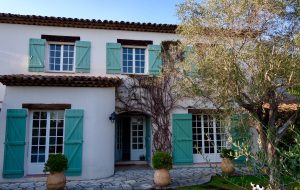 He disables the alarm and lets us in to an empty house, releasing us from his custody. Where are our hosts though? We have learned that the first thing you should do in a home exchange is read the instructions, even if you’re not the exchanger. The wifi code is always there. We pickup an email from Ken letting us know when they will return to the house, Viola. Even though we have European sim cards we are not getting consistent cell service outside of wifi enviornments. I send him back a quick response letting him know not to rush, that we not only found the house but figured out a way in. I’m glad we’re all good friends.
He disables the alarm and lets us in to an empty house, releasing us from his custody. Where are our hosts though? We have learned that the first thing you should do in a home exchange is read the instructions, even if you’re not the exchanger. The wifi code is always there. We pickup an email from Ken letting us know when they will return to the house, Viola. Even though we have European sim cards we are not getting consistent cell service outside of wifi enviornments. I send him back a quick response letting him know not to rush, that we not only found the house but figured out a way in. I’m glad we’re all good friends.
It turns out that David is the very protective gardener and handyman. He checks on us at breakfast time the next day to make sure all is as expected. We thank him for trusting us as best we could.
An Aix kind of day
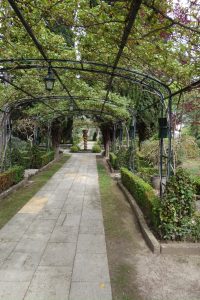 We had an afternoon alone in our Cezanne inspired hotel garden that was just magical. It felt a world away, private and made just for us. It gave us a chance to reflect on our trip, it’s diversity and all of the age appropriate adventures that we have had. The garden is just a couple hundred meters from a busy thoroughfare into the main square of Aix in Provence. The city’s main fountain is surrounded by construction equipment, pedestrian fences, and workers in florescent clothing. Our guide said that some of the work won’t be done until 2020 and the residents are not happy about it. The cars, buses, and pedestrian traffic are all trying to stay on schedules that are difficult without the obstacles. It’s not a very South of France vision. Aix is just a bit bigger than Santa Barbara and feels that way. Students make up about one third of the population, the vibe is young and energetic. Warmer weather is about the only reminder that we have been gone a month. Today was the first full day that we didn’t need our jackets. The Plane trees are leafing out, starting to dress in their thick green foliage that will shade France from the summer heat.
We had an afternoon alone in our Cezanne inspired hotel garden that was just magical. It felt a world away, private and made just for us. It gave us a chance to reflect on our trip, it’s diversity and all of the age appropriate adventures that we have had. The garden is just a couple hundred meters from a busy thoroughfare into the main square of Aix in Provence. The city’s main fountain is surrounded by construction equipment, pedestrian fences, and workers in florescent clothing. Our guide said that some of the work won’t be done until 2020 and the residents are not happy about it. The cars, buses, and pedestrian traffic are all trying to stay on schedules that are difficult without the obstacles. It’s not a very South of France vision. Aix is just a bit bigger than Santa Barbara and feels that way. Students make up about one third of the population, the vibe is young and energetic. Warmer weather is about the only reminder that we have been gone a month. Today was the first full day that we didn’t need our jackets. The Plane trees are leafing out, starting to dress in their thick green foliage that will shade France from the summer heat.

The news of our home has gone mostly un-noticed, a world away, its like we are actually living abroad, not caring too much for our own country and it’s political drama. Ask yourself do you know what is going on in France today? It’s that kind of awareness for America that develops when away for awhile. V asked me today if I could live in France, surprised I noted it’s usually me that asks that question. My answer was not without the language, we both continue to feel like outsiders with little lingua franca between us and the locals.
While in Lyon a friend of ours mentioned that he wants to stay in France for a year. He has just a few preconditions including fluency, a townhouse with high ceilings and a view, a fast car and enough € to keep petrol in it. I added; what about guest room? Yes it would be fun to live abroad for some time. Like being seniors doing a gap year.
One of the advantages with a longer trip is we don’t spend much time in the shops. Our suitcases are just the right size with no room for ”finds” no matter how unique. We also don’t feel the need to see it all. Some are the best moments are unplanned and not in the local attraction.
Home still feels like a good destination for next week.
Aix in Provence April 16th 2018
Pezenas, a small town in France
 In France the people are more identified by where they live rather than what they are. Spanish, Italian, African seems less important than if you’re from Pezenas and you speak French. Why would you want to be anywhere but here, a resident might say? Even though just a few kilometers away those people feel the same pride about their town. The Mauritius waitress that served us is recognized more as resident of Pezenas than she is a Mauritian. She speaks French, English and Creole.
In France the people are more identified by where they live rather than what they are. Spanish, Italian, African seems less important than if you’re from Pezenas and you speak French. Why would you want to be anywhere but here, a resident might say? Even though just a few kilometers away those people feel the same pride about their town. The Mauritius waitress that served us is recognized more as resident of Pezenas than she is a Mauritian. She speaks French, English and Creole.
This appoach is also important in the wine that the French drink. The most noticeable, largest font on a wine label is usually the village or vineyard. Here you drink a location, not a particular varietal and most are familiar with the grape variety from the region, it’s just not the most important component.
This is a town that Rick Steves hasn’t written a word about as far as I know. I wonder if the publicity a town gets is good or bad. It definitely improves the economy but then there are the overpowering hordes in these little towns. The future could be even more crowded with Norwegian Air’s one way, no changes fare ($179.00) that will get you to Europe cheaper than flying LA to San Francisco.
Some of the places that we have been are cosmopolitan, the population used to having many languages spoken. Their language skills are good, and signage is in French and the Kings English to attract us to their establishments. Here in Pezenas that is not the case. We ate Italian pizza, a recipe the owner learned from his Sicilian grandfather in this very french town. I’m coining the type of communication we have in these small towns as ”language charades”, the lack of skills for all of the players result in lots of pointing, hand gestures, and body movements just to order tap water, house wine and an artichoke three cheese pizza. It must feel satisfying for all of us because by the time we left there is hand shaking with the proprietor/chief, many mercies, and lots of smiles and waving. Connecting with people even without a common language is a simple thing that makes a great trip. We both have found a different pace here, it’s okay to pretend like we live here and not have to be on the go all the time.
Pezenas is known for being one of the most beautiful towns not to miss, with 300 days of sunshine. Which means it rains for at least thirty, including the last three pretty much nonstop. Babette, the energetic owner of our Bed & Breakfast has said more than once ”the rain will be finished today.” She and Phillipe her husband had to canoe to a friends flooded property and move all the furniture to the second floor so it stays dry. I’m hoping for at least a few hours of sun before we head to Aix en Provence tomorrow.
While staying in Pezenas we visited La Grotte Clamouse, underground caverns formed by mineral rich water percolating through rock over a few million years. Translated, this means even in the cavern it’s drizzling. When it rains hard, the ground absorbs the precipitation like a sponge for two days and after that it explodes out of the fissures in the area. The live guide was French, the audio guide was English. I think the only thing we missed were the jokes he told in French to the delight of the locals. I will let the images tell the story.


Fact Check: Pezenas, population less than 10,000, is in the Languedoc-Roussillon area, the single biggest wine producing region of the world
Pezenas, April 14th 2018
Art on Stone
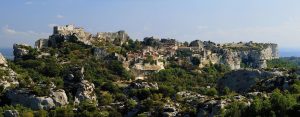
We have planned our trip up to Avignon, leaving the last two weeks without direction. After some deliberation between St. Remy or Les Baux en Provence, we decided to take the high road to Les Baux. We picked up the rental car and headed out of the city. The GPS must have a tourist setting that invites you on some beautiful back country roads (that are about as wide as a truck). Les Baux is a tiny wind blown hill town with a castle at the top. The population in the old town is 22, with 450 in the area.
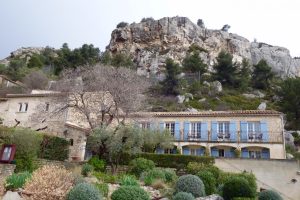
We stayed at Le Mas d’ Aigret just in view of the castle. The dining area of the hotel is partly carved in to the limestone mountain. The bar was once a stone vat for aging wine, red stained with the harvests of the past. Eric, the manager took us on a leisurely stroll through the property describing the history and amenities, including a “heated” outdoor pool. The area is infamous for the mistral winds that come from the north and last for days. Sorry there won’t be any swimming this week, no amount of heat can warm a mistral. Our room has a view of the countryside and the sea at Marseille, only partly obscured by the clouds.
Oh, and about the Troglodytes, they are giant cave dwellers that lived in the natural caverns surrounding the area a long time ago. Last night, after a day of rain I opened the terrace door and heard faraway thunder without the accompanying lighting. It was different though, it had a cadence almost like huge footsteps. I closed the door.
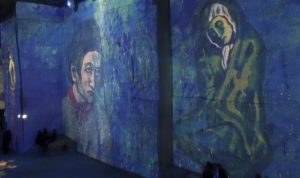
There is a hidden treasure in this little village called Carrieres de Lumieres. It is a unique projected presentation in an underground quarry. With the risk of of exaggeration I will describe the fantabulous light and music show that we saw. Picture a stone quarry carved into the hillside. The roof of the space is 5-7 floors above your head and there are 25’ square limestone pillars left in place to support the cavern, creating galleries though out the space. There are high tech projectors splashing fresco like images all around you. Your perspective and the presentation changes as you move through the quarry. It feels like you are in a painting that is evolving at warp speed. The walls, people, and the floor are covered with painted light. Every time you turn around the images change, fading in and out. All the while there is music that accompanies the projection, moving through you and bouncing off the walls, floor, and ceiling.

There were two different loops, one on Picasso and the Spanish Masters, another with a Beatles magical mystery tour/flower power feel. A PG rated lucy in the sky with diamonds experience, suitable for all demographics.
The presentation was mesmerizing and we and stayed for three loops, not able to draw ourselves away. Until the tour bus arrived and changed the vibe. We headed for the exit. When you walk out of the theatre of stone you are back in a little sleepy hill town, the contrast palpable.
 Fact check: The town of Les Baux draws 1.5 million tourists a year. The shows which have going on for 35 years and are different every year. No troglodytes have been seen for centuries.
Fact check: The town of Les Baux draws 1.5 million tourists a year. The shows which have going on for 35 years and are different every year. No troglodytes have been seen for centuries.
Les Baux de Provence, April 11th 2018
God and man
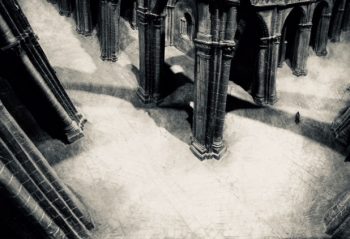
We spent hours in the Palais des Papes, in Avignon, the Vatican of the north, where the battling Popes took refuge in the 13th century. The guide book says it Is devoid of furniture but that’s not what you go for. The stark beauty, grandeur, and enormity of the palace is un-imaginable. There were many moments to just sit quietly in the spaces and try to absorb the stories held in stone.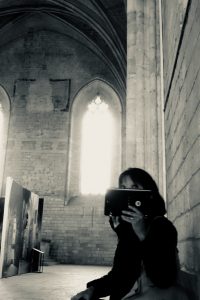
The meeting rooms, dining halls, and worship areas are opulent of space but empty of all else. With one small exception, there was a treasure chest along one wall and as I approached I felt an energy field. The presence was stronger than I have felt in a long time. Move away and no energy, move in for the vibration. The time travel iPads that all the visitors are given said there was a fire in that spot hundreds of years ago. The ashes and smell of smoke are gone but there is an essence of something that remains. Or?

Fact check: In 1791 during the French Revolution it became the scene of a massacre of counter-revolutionaries, whose bodies were thrown into the Tour des Latrines in the Palais Vieux.
 Over time the church would spare no expense to add a wing or another huge palace building that it thought that it needed. The tax collectors worked full time to enrich the coffers and manage the vast holdings of the church. They had their own rooms with vaults under the stone floor to bury the treasure. At one point there were over 1,500 people working here in the name of God. It’s about money, power and influence in the country. The war was for domination of the holy kingdom. This was not a place of worship for the pauper, it was only for the pleasure of the Papacy and I’m unclear how the people fit in to the scheme.
Over time the church would spare no expense to add a wing or another huge palace building that it thought that it needed. The tax collectors worked full time to enrich the coffers and manage the vast holdings of the church. They had their own rooms with vaults under the stone floor to bury the treasure. At one point there were over 1,500 people working here in the name of God. It’s about money, power and influence in the country. The war was for domination of the holy kingdom. This was not a place of worship for the pauper, it was only for the pleasure of the Papacy and I’m unclear how the people fit in to the scheme.
Maybe mortality is part of the story here. Man can never be immortal so he strives for to create things that will outlive him by centuries and willing to spend vast sums to accomplish it for the glory of God.
Avignon, April 9th 2018
On and off the river
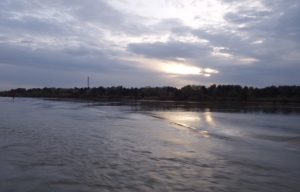 I was writing in the Leopard Bar, fondly referred to by my shipmates as the Cougar Bar. It’s the last full day of the river cruise from Lyon to Avignon and the Rhône is making its way to the sea as it has for all the days on the cruise and for thousands of years before we got here. It occurred to me that the volume of Santa Barbara’s desalination plant is going by every few minutes. It’s easy to take water for granted when it’s always there, and it’s definitely here thanks to the Alps.
I was writing in the Leopard Bar, fondly referred to by my shipmates as the Cougar Bar. It’s the last full day of the river cruise from Lyon to Avignon and the Rhône is making its way to the sea as it has for all the days on the cruise and for thousands of years before we got here. It occurred to me that the volume of Santa Barbara’s desalination plant is going by every few minutes. It’s easy to take water for granted when it’s always there, and it’s definitely here thanks to the Alps.
The river, the boat, and the people have all been a wonderful experience that I would consider again. The best part is the connections you make with your shipmates. We have all promised to meet again in Santa Barbara probably to drink French wine and eat a meal together. Speaking of food, some days on the boat you feel that you are in the continuous buffet line with not enough activity to justify the calorie intake. Admittedly, after just five days, I’m looking forward to every meal. The food is very good, with more choices than you could try on a voyage three times as long.
The boat carries a top flight contingency of mostly Eastern Europeans fleeing their governments corruption and people’s poverty. Miro, our Bulgarian waiter is preforming parlor tricks along with table service. His sense of humor only partly disguises his professionalism.
After just a couple of days he was teasing us and remembering our favorite choices like we were all old friends. The company treats them very well, and they seem to love their jobs, and that translates into excellent service that appears to be genuine.
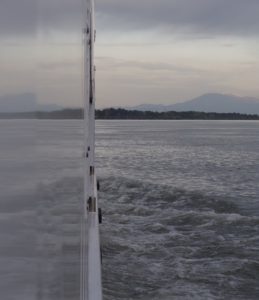 The ship is small, but too long to dock in some river ports, and too high to make it under some bridges during high water times. There are about 140 people aboard, which is as big a boat that I would want to be on. A friend aboard told me of a recent cruise he did with six people aboard and four crew members. They would plan meals with the crew who shopped that day and cooked for them. Sounds like this might be a better alternative if we were to hit the river again. Kind of like a floating bed and breakfast
The ship is small, but too long to dock in some river ports, and too high to make it under some bridges during high water times. There are about 140 people aboard, which is as big a boat that I would want to be on. A friend aboard told me of a recent cruise he did with six people aboard and four crew members. They would plan meals with the crew who shopped that day and cooked for them. Sounds like this might be a better alternative if we were to hit the river again. Kind of like a floating bed and breakfast
Today is bon voyage to the friends that we met and the staff that cared for us. Tania, the Activities Director said: “don’t cry that it’s over, smile that it happened”.
Avignon April 8th 2018
Don’t eat the truffles
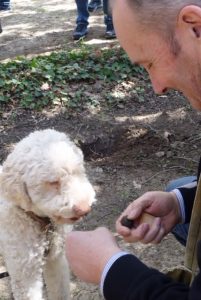 We spent a couple of hours with a French truffle farmer, Serge and his Italian dog, Amy. They took us to work with them in the fields, where there are trees interspersed with lavender and other herbs de Provence. The tree that is the source of much of the production is a type of oak, similar to the Coastal Live Oak found in California. For this magic mushroom to grow you need a couple of other factors: weather and ph soil between 6.5-8.0. To start the seedling, acorns from infected trees are sprouted in a mixture of ground-up mushrooms and soil with the hope that the mycelium will infect the seedling and be carried by the tree as it matures. The seedlings are planted in rows for the future generation to harvest. The older trees are removed as they become less productive. Just as Serge has replaced his father, grandfather, and grandfather’s grandfather, he will eventually be replaced by his son.
We spent a couple of hours with a French truffle farmer, Serge and his Italian dog, Amy. They took us to work with them in the fields, where there are trees interspersed with lavender and other herbs de Provence. The tree that is the source of much of the production is a type of oak, similar to the Coastal Live Oak found in California. For this magic mushroom to grow you need a couple of other factors: weather and ph soil between 6.5-8.0. To start the seedling, acorns from infected trees are sprouted in a mixture of ground-up mushrooms and soil with the hope that the mycelium will infect the seedling and be carried by the tree as it matures. The seedlings are planted in rows for the future generation to harvest. The older trees are removed as they become less productive. Just as Serge has replaced his father, grandfather, and grandfather’s grandfather, he will eventually be replaced by his son.
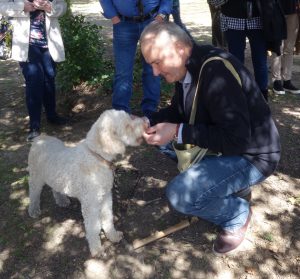 The dogs are trained from birth by feeding the mushrooms to the puppies until they acquire a taste for these little black gems. Pretty difficult to eat dog food after this regimen. Amy leads us and the farmer to the grove and immediately starts digging in the soft soil around the trees. She’s a rascal dog that pays little attention to her master, eating a truffle or two when he’s not looking. He scolds her in French, a language that she’s obviously not familiar with. Then he gives her a dog biscuit as a reward for not eating the entire crop. That’s the problem with dogs that only speak Italian. The reason that they use mostly dogs these days is that hogs are so hard to control, they eat up more of the profits than Amy does.
The dogs are trained from birth by feeding the mushrooms to the puppies until they acquire a taste for these little black gems. Pretty difficult to eat dog food after this regimen. Amy leads us and the farmer to the grove and immediately starts digging in the soft soil around the trees. She’s a rascal dog that pays little attention to her master, eating a truffle or two when he’s not looking. He scolds her in French, a language that she’s obviously not familiar with. Then he gives her a dog biscuit as a reward for not eating the entire crop. That’s the problem with dogs that only speak Italian. The reason that they use mostly dogs these days is that hogs are so hard to control, they eat up more of the profits than Amy does.
This fungus sells for €1000’s per kilo at the wholesale level. Some of the selling takes place in organized markets. Picture town squares full of black Mercedes, well dressed traders, expensive lunches, small sheets of paper with offers to buy in cash, all difficult to track and tax. Once the days end, the town square is swept, the black cars, black diamonds, and chits are gone. The only thing left is a lingering smell of the truffle. And every year is a bad year in the mushroom business according to the taxing authorities.